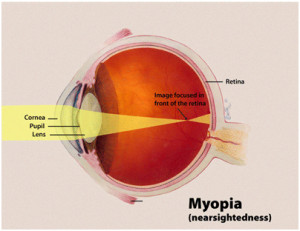 Myopia is a condition that results from the eye being larger, or longer (from front to back) than normal. When we look at a distant object, the light rays bounce off of the object and travel toward our eyes. With normal vision, the light rays pass through the various parts of the eye and focus on the retina (the layer lining the inside of your eye), allowing for clear vision. When the eye is slightly larger, or longer than normal – as is the case with myopia – the light rays will come to a focus in front of the retina (as opposed to directly on the retina), producing blurry vision. People with myopia will have trouble seeing distant objects, but near objects such as a book, magazine, or computer screen are seen clearly. This is due to the fact that a closer object will direct light rays such that they will focus directly on the retina, allowing for clear vision with close-up viewing. Myopia to the point of needed spectacle correction is rarely present from birth. Instead the growth of the eye typically occurs as the rest of the body is growing through childhood, puberty, adolescence, and through the high school and college years.
Myopia is a condition that results from the eye being larger, or longer (from front to back) than normal. When we look at a distant object, the light rays bounce off of the object and travel toward our eyes. With normal vision, the light rays pass through the various parts of the eye and focus on the retina (the layer lining the inside of your eye), allowing for clear vision. When the eye is slightly larger, or longer than normal – as is the case with myopia – the light rays will come to a focus in front of the retina (as opposed to directly on the retina), producing blurry vision. People with myopia will have trouble seeing distant objects, but near objects such as a book, magazine, or computer screen are seen clearly. This is due to the fact that a closer object will direct light rays such that they will focus directly on the retina, allowing for clear vision with close-up viewing. Myopia to the point of needed spectacle correction is rarely present from birth. Instead the growth of the eye typically occurs as the rest of the body is growing through childhood, puberty, adolescence, and through the high school and college years.
Treatment of Myopia
Glasses and/or contact lenses are used to provide excellent vision to those who are nearsighted. There are also surgical options that can be useful to correct for nearsightedness. If you are interested in seeking a surgical solution for nearsightedness, please speak with one of our doctors who will be happy to assess if you are a candidate for surgery and answer any questions you may have.


